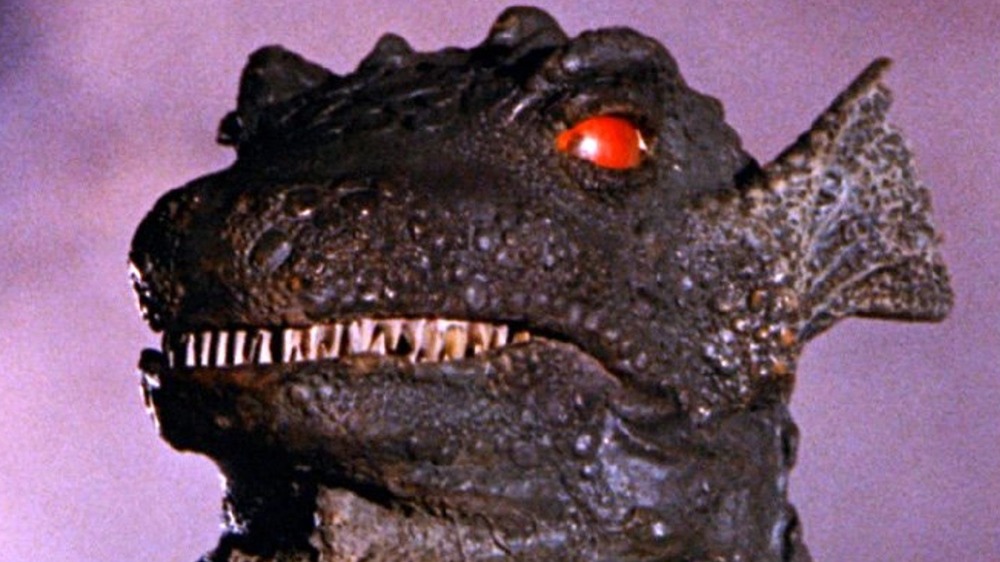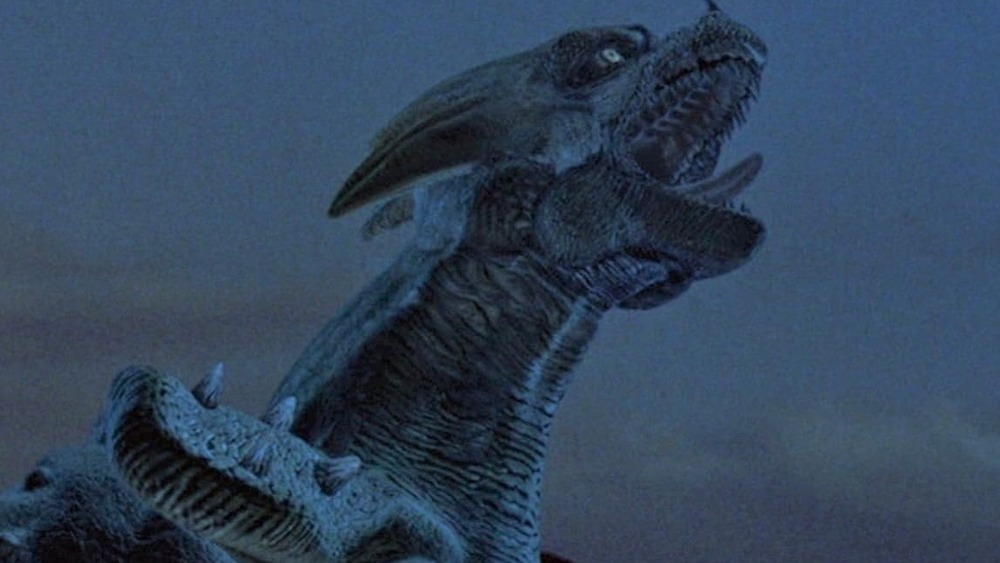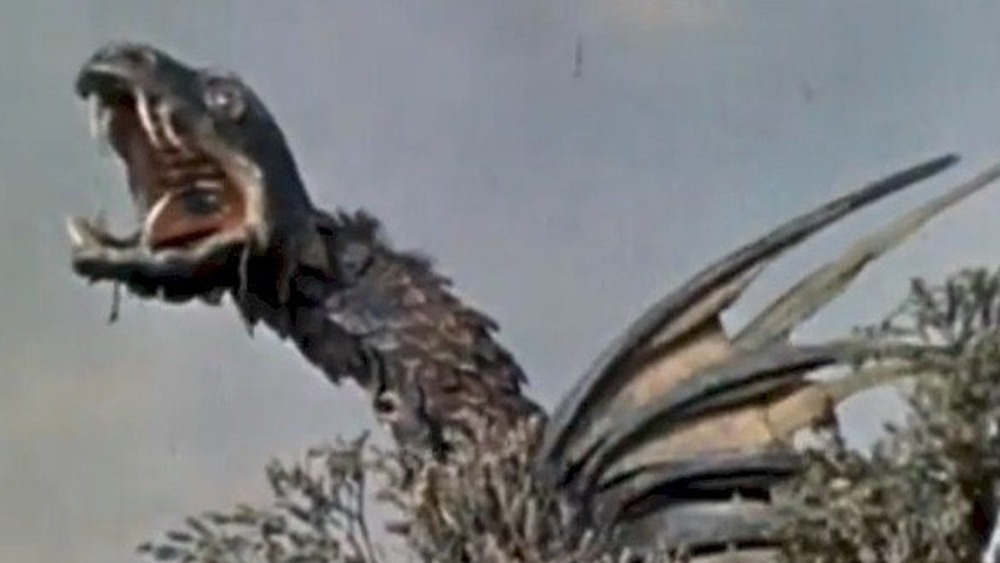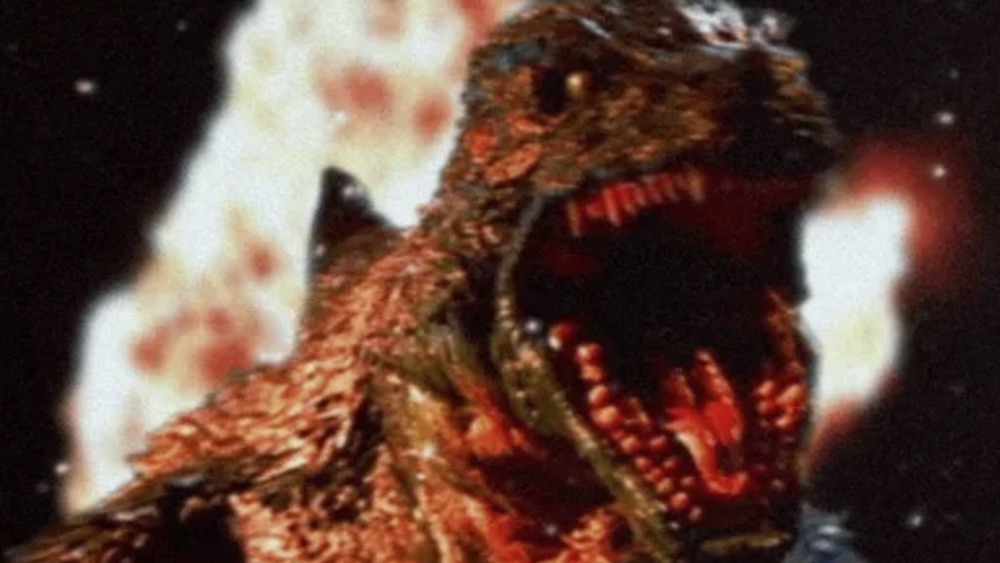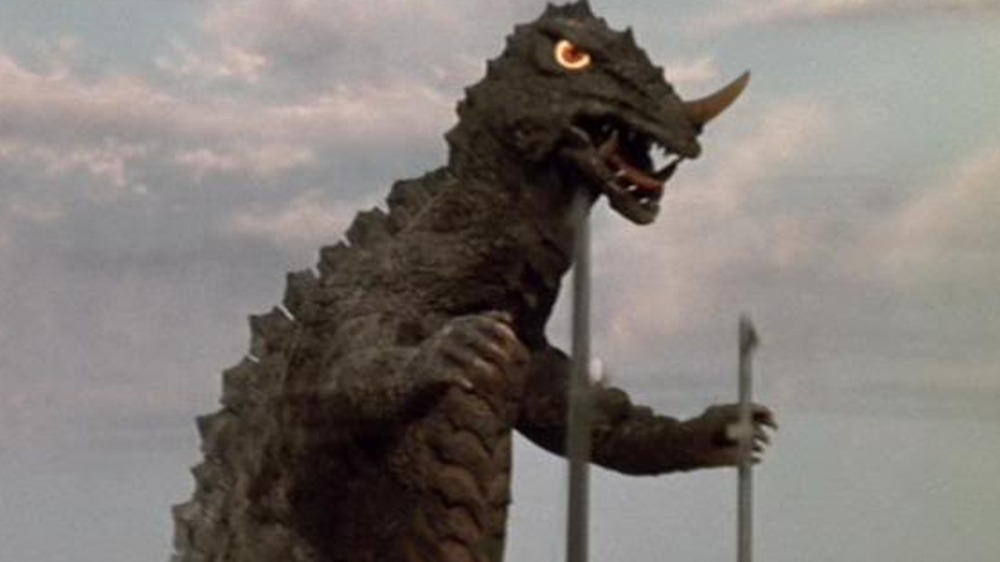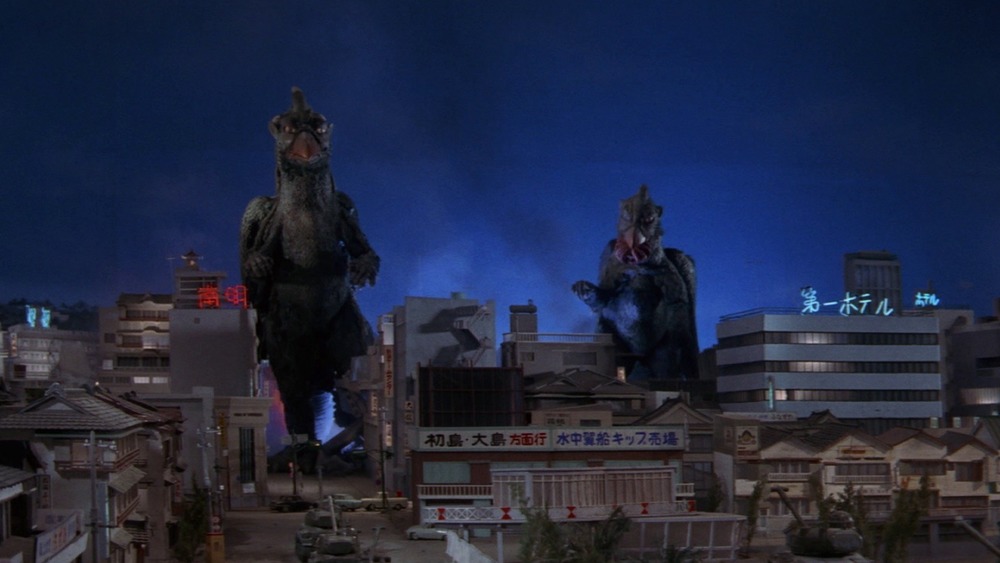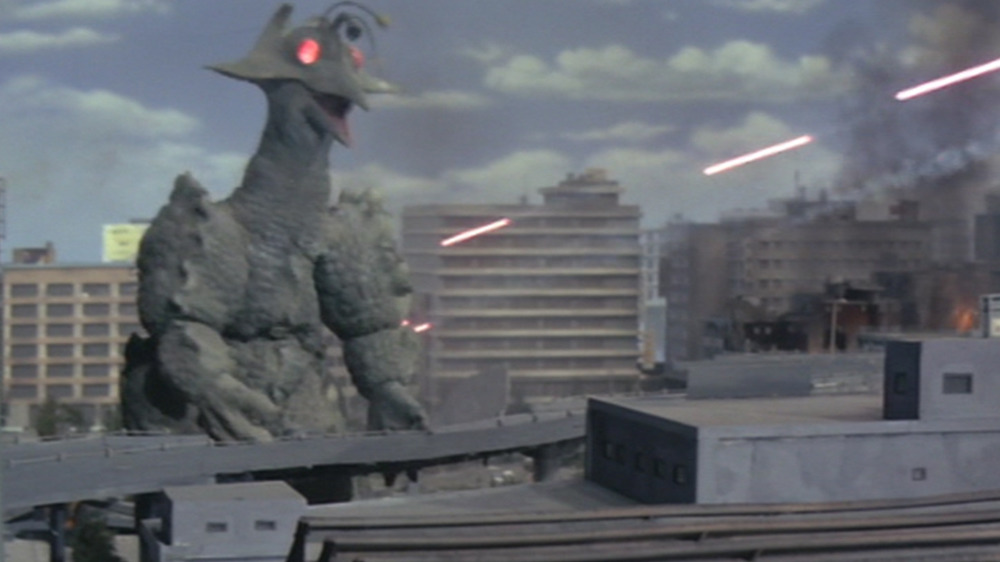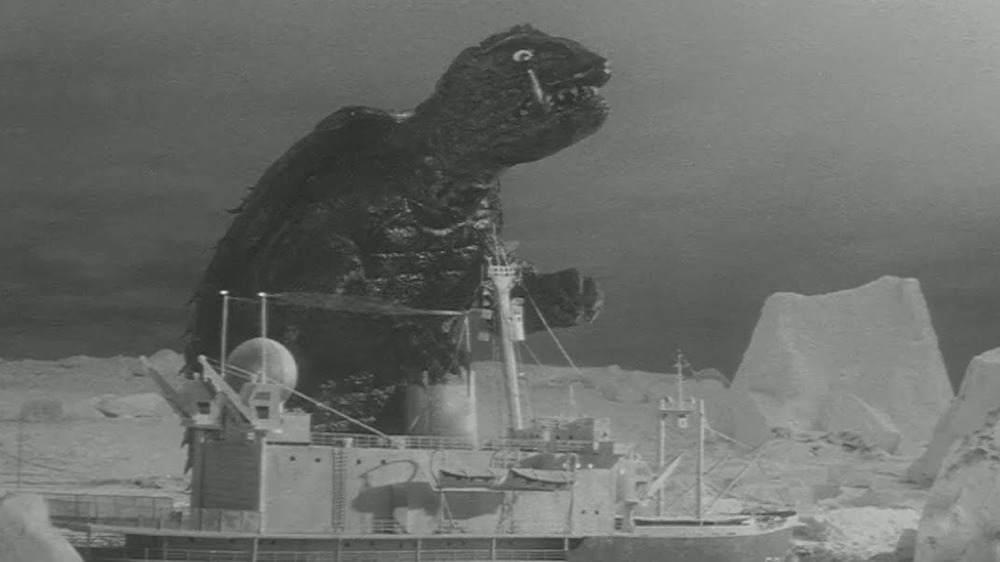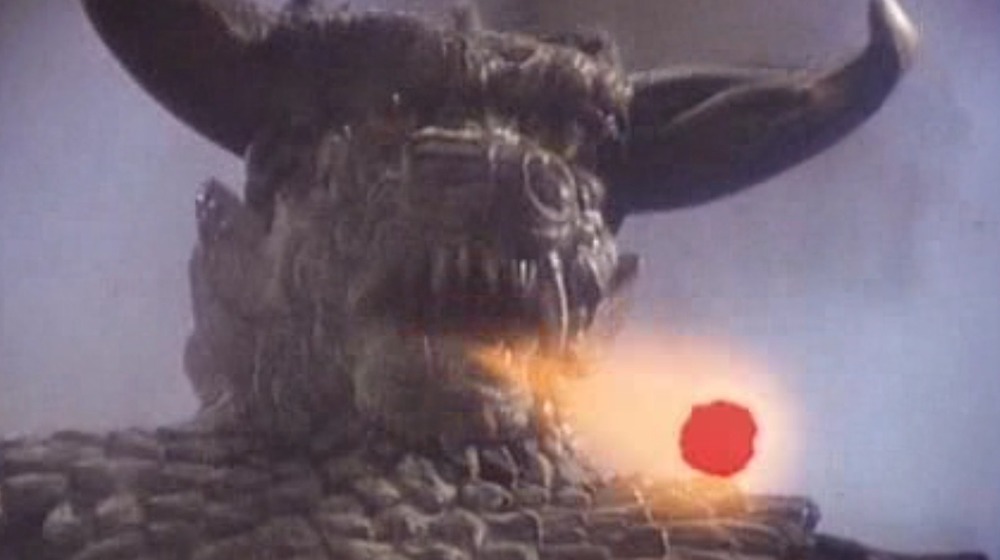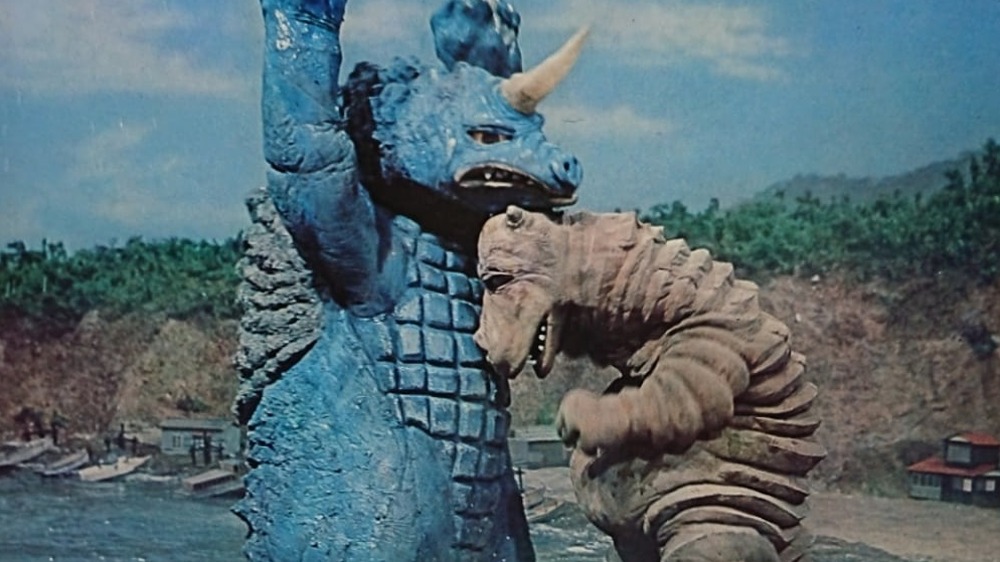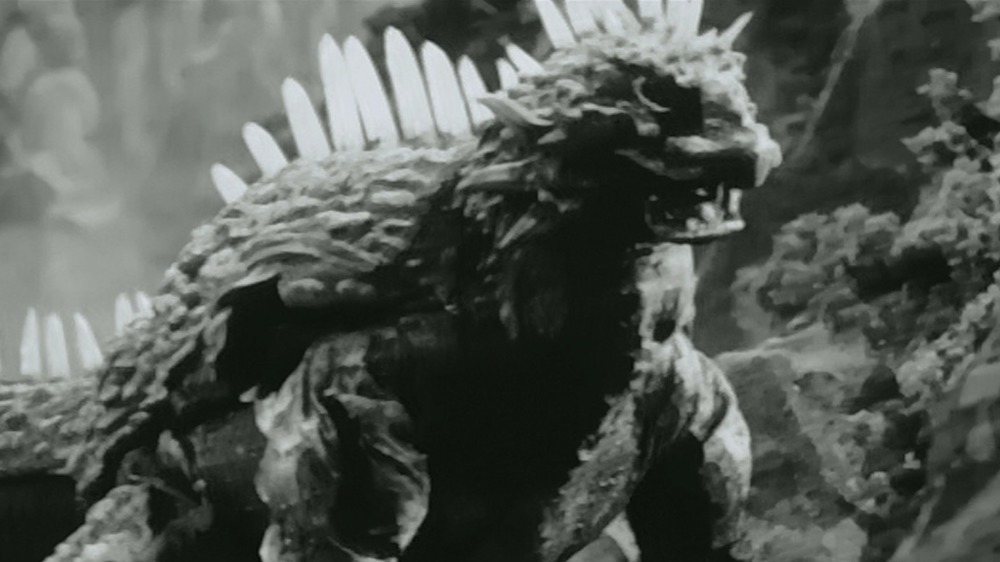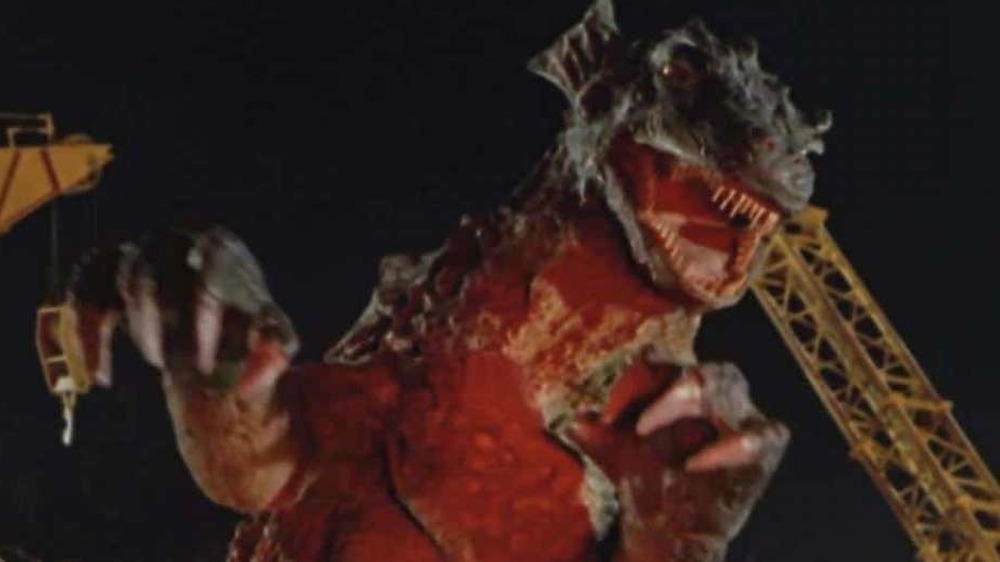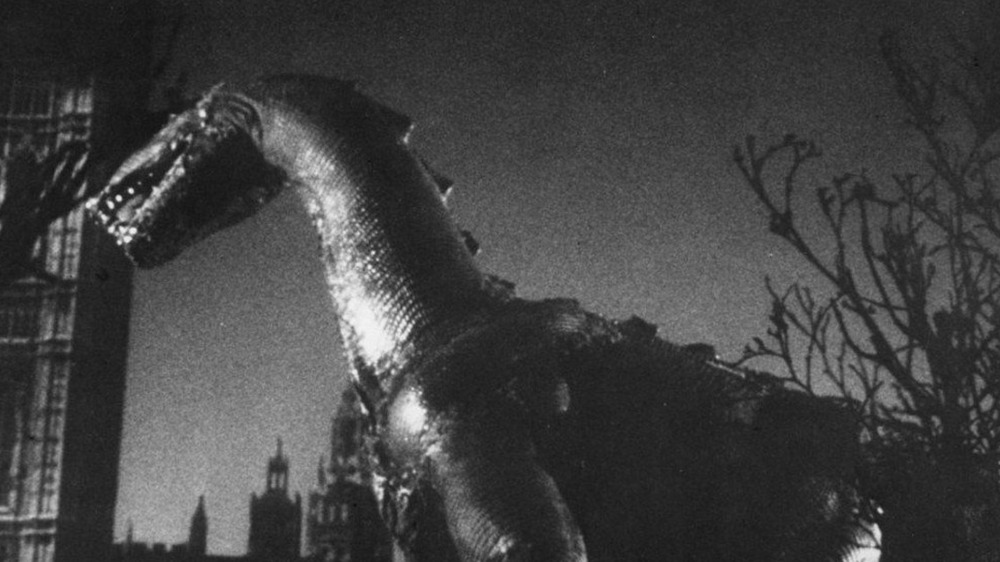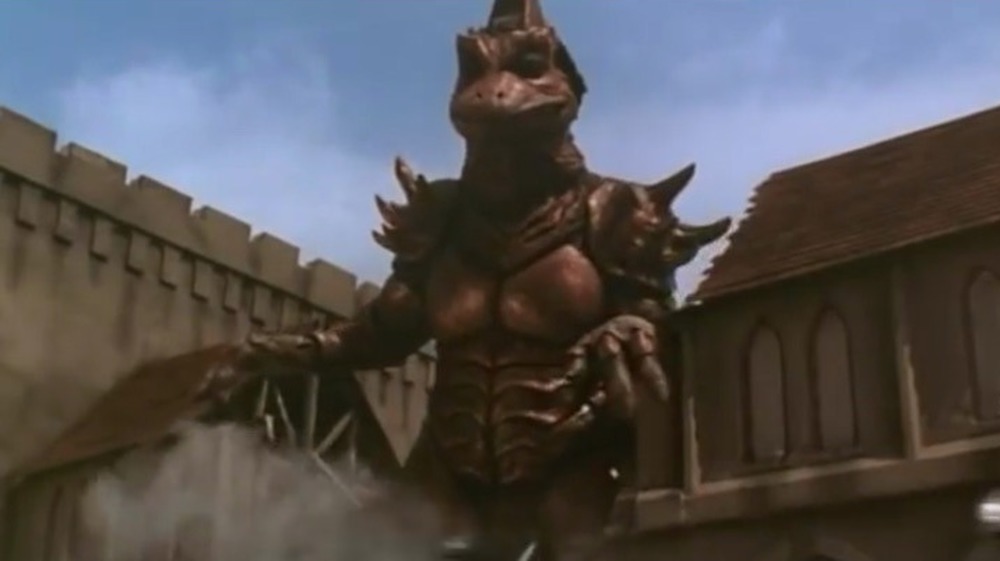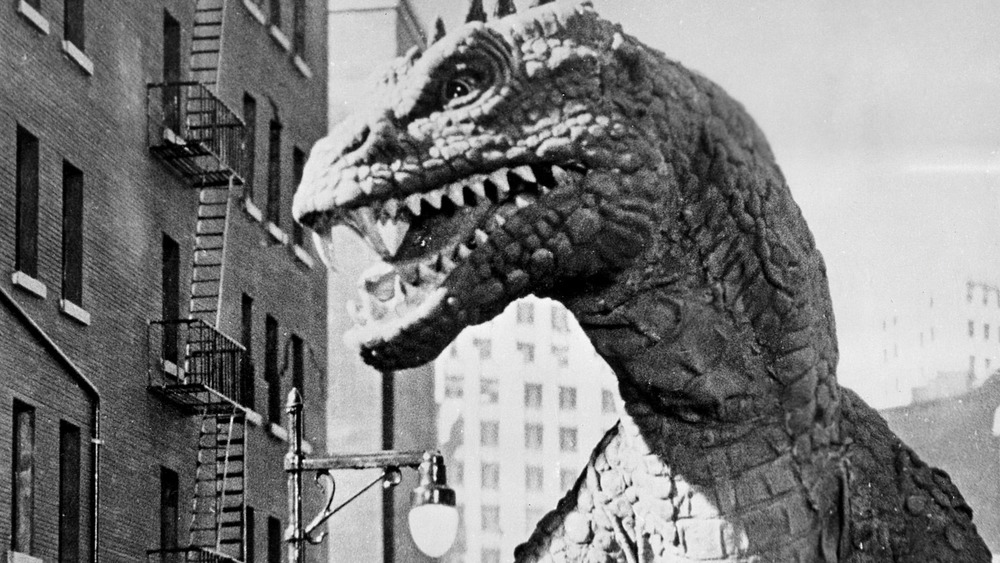Bizarre Godzilla Rip-Offs You Never Knew Existed
Legends of sea monsters date back centuries, but the most famous one of all rose up from the depths of Tokyo Bay nearly 70 years ago – Godzilla, King of the Monsters. Godzilla immediately left a huge mark on the pop cultural landscape because he wasn't any ordinary sea monster. Godzilla was suffused with blatant overtones of nuclear death and destruction, and he was a metaphor for the eternal conflict between humankind's hubris and nature's wrath. Also, he was played by a man in a suit ... that was pretty memorable, too.
Godzilla may have started as Japan's answer to American B-movie sci-fi, but he spawned a new sub-genre of tokusatsu (Japanese sci-fi/fantasy): the kaiju film. In the decades that followed, legions of rip-offs have come and gone, and not just in Japan, as Godzilla's visage has been "borrowed" around the world. Some spawned popular franchises in their own right, while others are so bad they deserve to be blasted with Godzilla's radioactive breath. While Godzilla launched the entire kaiju genre, we're only going to look at the movies that are obviously, ahem, "inspired" (to put it politely) by the King of the Monsters, where the plot can be summed up as "giant reptile-like monster destroys city." From Tokyo Bay to the River Thames, join us as we stomp around the globe to look at bizarre Godzilla rip-offs you never knew existed!
Reptilian is a wretched Godzilla rip-off
Big American movies frequently inspire blatant rip-offs, like Night of the Twisters or Titanic: The Legend Lives On. With Roland Emmerich's Godzilla being one of the most hyped movies of the 1990s, it was only natural that other studios would want to cash in on the action. But when Godzilla massively underwhelmed — contrary to popular belief it didn't "bomb" — any giant monster movie that came in its wake had the same stink on it. And Reptilian didn't need any more stink ... it was awful to begin with.
Reptilian was released in South Korea in 1999 as Yonggary, a loose remake of 1967's Yongary, Monster from the Deep. Two years later, it was upgraded with "better" (relatively speaking) special effects, sets, and even storyline for a 2001 re-release, 2001 Yonggary in South Korea and Reptilian for American home video. Directed by Hyung-rae Shim and starring a cast of Westerners, Yonggary/Reptilian is about a 200 million-year-old monster that aliens resurrect to destroy humanity. As cool as that sounds, the movie only mustered a meager 2.6/10 score on IMDb, and it's not hard to see why. Your N64 has better graphics, while the acting makes the SyFy Channel look like the Royal Shakespeare Company. Even for die-hard kaiju fans, this film is almost unwatchable.
Denmark's entry into the kaiju genre is dreadful
Over the past 60 years, the Danish film industry has given us Mad Mikkelsen and a giant, acid-spewing serpent inspired by Godzilla. You know a concept has caught hold when even a Scandinavian country of less than 6 million people wants to get involved. Five years after the Americanized Godzilla: King of the Monsters was released in 1956, there was Reptilicus, a 1961 Danish-American co-production about a prehistoric serpent that wreaks havoc in Copenhagen. Perhaps he was a fan of chocolate?
However, Reptilicus is actually two movies — a Danish version and an American, with the same casts but two different directors. The filmmakers would literally film once in English, then rearrange the lighting and camera angles to shoot in Danish. Why not just dub the Danish version into English like Toho did for decades? Beats us. Anyway, the American version was so bad the studio originally didn't accept it. While the Danish version is "better," only the American version has been widely available. Reptilicus was rightly ridiculed far and wide, but it was a classic episode on Mystery Science Theater 3000.
This independent Japanese kaiju flick wastes its inspired premise
While the 1950s and 1960s were the heyday of giant monster movies, kaiju flicks were still being made in the 2000s. Case in point, Reigo, the Deep-Sea Monster vs. the Battleship Yamato, a 2005 independently financed Japanese movie. It almost takes longer to say that title than it does to watch the movie, which is only 81 minutes. However, sitting through it is a long 81 minutes.
Reigo actually has a pretty compelling premise. Set during World War II, the film pits the real-life Japanese battleship, the Yamato, against Reigo, the most ferocious creature in a Pacific Ocean populated by monsters. If only the movie lived up to the promise of its setup. While we can give Reigo kudos for being an indie kaiju movie, the cheap-looking CGI proves that special effects should usually be left to the experts. What it lacks in quality, it makes up in pretension, with a hackneyed, tacked-on anti-war message that's way out of place for this cheesy snooze-fest.
It was also released with the much less clunky titles Deep Sea Monster Reigo and Reigo: King of the Sea Monsters (how did they not get sued for that?), but whatever you call it, it's still bad.
Yongary may be the most memorable non-Japanese Godzilla rip-off
The best made-up character names are meaningless without context, but they somehow embody a character perfectly — Gandalf the wizard, Yoda the Jedi, and Godzilla the giant radioactive sea monster. On the flip side, there are names that are just awkward, like Yongary, the titular kaiju in South Korea's 1967 answer to Godzilla, Yongary, Monster from the Deep. Pronounced "Yawn-Gary," it sounds like a nickname for a boring dude named "Gary." It's etymology actually stems from "yong," which is Korean for "dragon," and "gongryong," meaning "dinosaur."
"Dino-Dragon" sounds like the coolest thing ever (way better than Gorilla-Whale, the actual meaning behind Godzilla's Japanese name, Gojira). However, the movie falls far short of Toho's 1960s sci-fi spectacles, despite costing 13 million won — nearly four times the average Korean movie at the time — and the involvement of Japanese special effects artists. While it's not great, Yongary may be the most notable non-Japanese Godzilla knockoff, and it's worth a watch for that reason alone.
Gappa is crappa
It's only natural that the Land of the Rising Sun is the epicenter for Godzilla rip-offs. Case in point, Gappa, the Colossal Beast, the Nikkatsu Corporation's first and only foray into the kaiju genre. Gappa was dubbed in English and released for foreign sales under the clunky title Gappa, the Triphibian Monster, which at least made sense, as Gappa could walk, swim, and fly. What didn't make sense was the American title that distributors gave it for TV: Monster from a Prehistoric Planet. Gappa came from Earth, which we guess can be considered prehistoric?
Anyway, Gappa follows the usual beats — greedy humans steal baby monster from South Pacific island, Mommy and Daddy Monster wreak havoc to get it back. The story is basically Gorgo meets Mothra, while the beaked monsters look like a cross between Godzilla and Rodan. It's been claimed Gappa is actually a satire of kaiju movies, which was lost in translation. By 1967, this film was already a corny cliche.
The X from Outer Space is anything but excellent
We've got to be honest, we're pretty in love with this title. "X" is a letter, not a noun, so are people supposed to know what an "X" is and be intrigued that it's from outer space? Like, why not The Monster from Outer Space or The Evil, Mutant Planet-Destroyer? Nope, just "X." They might as well have left it blank. Not that we should be surprised. How else could you describe this film's star creature, which has to be the goofiest kaiju in the history of the genre?
It's basically a four-limbed glob of grayish-green moss with a manta ray for a head, and it walks so off-balance that it looks like a stiff gust of wind could knock it over. While the movie has a pretty good storyline — astronauts return with Martian space spores that grow into a colossal beast — it's just too silly to take seriously, even when grading on a kaiju curve. And yet, we're thrilled to say it's part of the Criterion Collection, proving even stuffy film snobs have a sense of humor.
Gamera is the most famous Godzilla rip-off
Every giant monster movie fan knows about Gamera, though he may still be a mystery to non-fans. But Gamera is certainly a bizarre Godzilla rip-off, so he definitely qualifies for this list. With 12 movies in two separate eras, the Gamera series was a contender (though never a serious threat) to the King of the Monster's crown. Gamera's 1990's trilogy is even considered to be among the greatest kaiju movies ever made. However, we're only going to include the first film — Gamera: The Giant Monster. What an underwhelming title. Why not Gamera: The Giant, Freaking Fire-Breathing Turtle?
Released in 1965 by Toho rival Daiei, which produced Akira Kurosawa's 1950 masterpiece Rashomon, Gamera is the kind of movie you'd come up with if you were 13 (which is why we love it). A flying, fire-breathing turtle with tusks, who's a friend to children but an enemy to humankind, threatens to destroy Japan until he's blasted off to Mars in a rocket. While the 1960s-1970s Gamera series descended into sheer lunacy — Gamera eventually fought an alien lizard with a knife for a head and a flying space shark — it was the most successful non-Godzilla, non-Toho kaiju franchise. Even if you never knew he existed, the titanic terrapin belongs in giant monster history books.
A director was kidnapped to make this North Korean communist kaiju flick
Pulgasari is the most insane Godzilla rip-off, a dubious honor it earned before a single frame of film was even shot. North Korean dictator Kim Jong-il, father to current dictator Kim Jong-un, wanted a blockbuster that would – according to a Vanity Fair – "elevate his country in the eyes of the world and educate international audiences on the communist values of the D.P.R.K. (Democratic People's Republic of Korea)." Underwhelmed with the cinematic output of his own worker's paradise, Kim did what any cinema-loving communist dictator would do — he kidnapped the hottest power couple in South Korean cinema, director Shin Sang-ok and actress Choi Eun-hee.
With his wife being held hostage, Shin created seven films for Kim, the final one being Pulgasari. Based on a Korean mythological creature, the film is about peasant farmers who rise up against a tyrannical despot (the irony was lost on Kim) by crafting a figure into a monster, Pulgasari. Kim hated the Japanese, but he admired The Return of Godzilla (released in America as Godzilla 1985), so he flew in — but didn't kidnap — that film's crew to help with Pulgasari. Longtime Godzilla-suit actor Kenpachiro Satsuma even played Pulgasari. While Pulgasari was only available on bootleg copies for years, it got a brief run at a Brooklyn arthouse theater in 2015. Too bad there wasn't a behind-the-scenes documentary.
Daigoro vs. Goliath was meant for kids, but it appeals to nobody
What if H.R. Pufnstuf, the title character from the trippy 1969 kid's TV series, was a kaiju movie? It probably would look a lot like Daigoro vs. Goliath. By 1972, the year of Daigoro vs. Goliath's release, the kaiju genre had long since abandoned dark nuclear allegory for a more kid-friendly approach in order to lure children back to the theater and away from watching TV shows like Ultraman, the popular precursor to super sentai shows like Power Rangers.
Daigoro vs. Goliath was a co-production between Godzilla studio Toho and Tsuburaya Productions, the company founded by longtime Toho SFX master Eiji Tsuburaya, which found incredible success with Ultraman and his spin-offs. As for the plot, while an inventor and his family struggle to raise a giant monster named Daigoro, another giant monster, Goliath, rises from the ocean after a meteor strike. This "friend to children" trope had already been done by Gamera, so Daigoro was a rip-off of a rip-off. No wonder even die-hard kaiju fans have probably missed this bizarre monstrosity.
Toho ripped off their own creation with Varan the Unbelievable
Does it count as plagiarism if you're ripping off yourself? Toho's Godzilla series was on hiatus after 1955's Godzilla Raids Again, as the idea of releasing a Godzilla movie every year wasn't on the cards until 1962's smash hit, King Kong vs. Godzilla. So instead of making more Godzilla movies, they made more kaiju movies, including two of the most famous of all time, 1956's Rodan and 1961's Mothra. In between came the much less popular Godzilla rip-off, Varan the Unbelievable. What makes Varan unbelievable?
He's basically a giant iguana that can glide like a flying squirrel due to a patagium — a parachute-style membrane in between his arms and legs. So points to Toho for originality there. Varan didn't hit big like Rodan or Mothra and certainly not like Godzilla, and he only appeared again in a "blink and you'll miss him" cameo in 1968's Destroy All Monsters. The 1962 American Varan, with a modified storyline and new footage of American actors, a la 1956's Godzilla: King of the Monsters, only managed a meager 4.8/10 score on IMDB, while the Japanese version scored a 5.5/10. Why the gap? While neither version is "good," the American version took an A-list production in Japan and turned it into your typical "nuclear monster run amok" B-movie.
Gorgo is pretty great
Gorgo – a 1961 co-production between the United Kingdom, Ireland, and the United States — is one of the best Godzilla rip-offs ... and one of the most blatant. Despite the poster proclaiming "Like Nothing You've Ever Seen Before," the title monster is clearly a Godzilla clone when it comes to the design. (Godzilla is basically a bipedal T-rex with Stegosaurus spikes; Gorgo is a bipedal T-rex with a crocodile-like "shell.") However, the movie's storyline was pretty original.
Rather than being awakened by nuclear weapons, like virtually every other giant monster in the 1950s and 1960s, Gorgo is a ticked-off mom who attacks London after her baby is kidnapped, a storyline Jaws 3-D pretty much "borrowed" verbatim in 1983. Spoiler alert — Gorgo survives at the end, perhaps to set up future Gorgo vs. Another Monster sequels, though maybe not, as the money-printing "versus" concept was another year away with 1962's King Kong vs. Godzilla. Either way, Gorgo was a one-and-done story, and it was a pretty good one at that.
The Giant Behemoth is Great Britain's contribution to the genre
The worldwide popularity of the Americanized Godzilla: King of the Monster's in 1956 meant even movie studios across the pond wanted in on the action. Enter 1959's The Giant Behemoth, a British production whose poster boasts it's "The Biggest Thing Since Creation!" That might be over-selling the film just a little, but we'll allow it.
The storyline should sound familiar — a long-dormant dinosaur who can shoot nuclear breath attacks a city after being awakened by atomic tests in the ocean. Trade London for Tokyo, and you've basically got Godzilla but with British accents. However, The Giant Behemoth is unique in the kaiju genre, as the titular behemoth was brought to life not by a man in a suit but the far more painstaking and time-consuming stop-motion animation process. It's the same technique that was used in the original King Kong, and it involves recording a model frame by frame to create the illusion of movement — much like this movie created the illusion of originality.
Giant monsters go medieval in Galgameth
Have you ever thought, "Hey, Godzilla's cool and all, but he'd be so much better in medieval Europe"? Well, even if you haven't thought that, the filmmakers behind The Legend of Galgameth did. The 1996 film was written by Pulgasari's director, Shin Sang-ok, who'd been kidnapped and held prisoner in North Korea to shoot the aforementioned 1985 communist kaiju flick. We assume the filming experience was a little better on Galgameth, though the film does tell a similar story, trading feudal Korea for the fictional medieval kingdom of Donnegold.
In the film, a young prince seeks to reclaim his deceased father's throne from a traitorous knight with the help of Galgameth, his family's dragon. The reason this film counts as a Godzilla rip-off and not just your run-of-the-mill medieval fantasy is Galgameth is clearly based on Godzilla, as he looks less like the ancient dragons of lore and more like, well, the King of the Monsters. While Galgameth won't go down in the history of great family films, it's still an enjoyable kid-friendly kaiju flick.
Is Godzilla ripping off The Beast from 20,000 Fathoms?
Every other movie on this list is a rip-off of 1954's Godzilla ... but what about The Beast from 20,000 Fathoms, which came out in 1953? Is Godzilla, one of the most famous characters ever, a knockoff? Fathoms' special effects director, the legendary Ray Harryhausen, certainly thought so, telling The Guardian, "Oh, the Godzilla stuff was a direct ... filch from The Beast from 20,000 Fathoms." The stories are similar. Very loosely based on sci-fi icon (and Harryhausen's high school buddy) Ray Bradbury's short story "The Foghorn," Fathoms is about a dinosaur that's revived by nuclear weapons and attacks a city.
So yeah, it's basically Godzilla, which came out in Japan 16 months later. But as Film School Rejects put it, "Godzilla nabbed the B-movie fears of The Beast from 20,000 Fathoms and elevated them to A-movie terror." Put another way, Fathoms is your typical "nuclear monster-run-amok" movie that was dominant in the 1950s, just with a dinosaur instead of the ants in Them!, a condor in The Giant Claw, or a Gila monster in, well, The Giant Gila Monster. Godzilla transcended that genre and created its own, the kaiju film, as evidenced by the character's staying power. That said, Fathoms deserves some love and is among the best of its genre.
